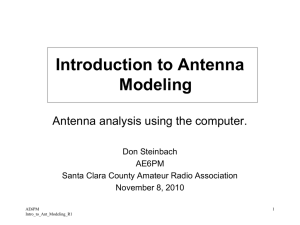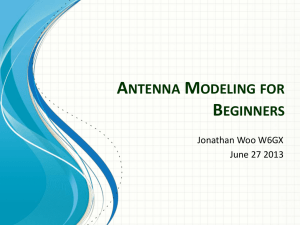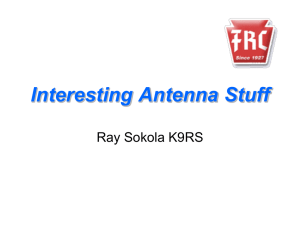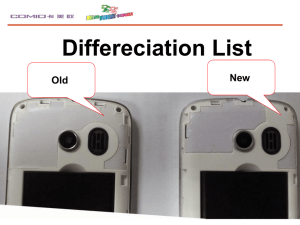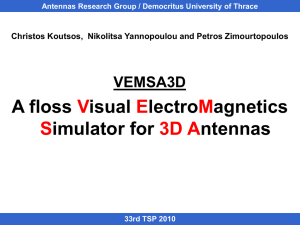2M Moxon
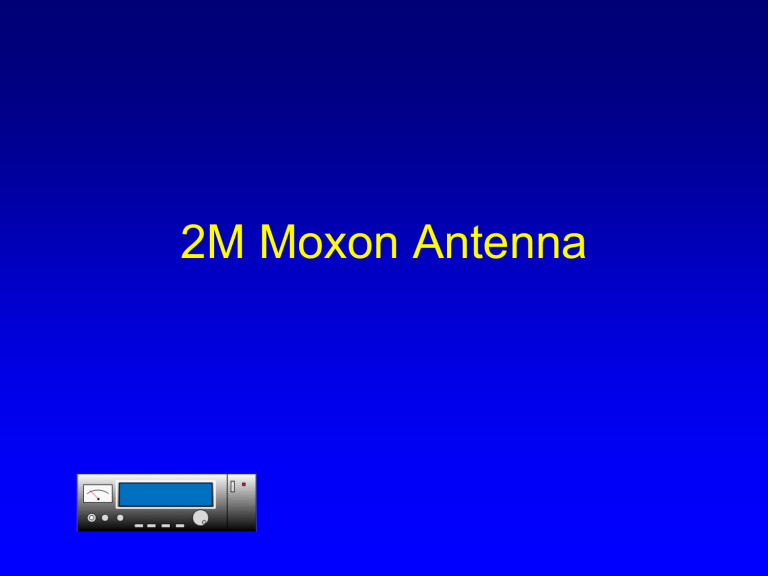
2M Moxon Antenna
Moxon Antenna
• Moxon antenna is a 2 element reduced size antenna.
• The Elements are bent (reducing the size)
• It has similar characteristics as a 3 element yagi.
• It has a large beam width and very good
Front-to-Back ratio.
Moxon cont’d
• Use Moxon Generator (freeware) to calculate the size of the antenna.
• Insert the dimensions into a Antenna
Modeling program. (Most of the diagrams are from cocoaNEC – MAC program)
• Determine the characteristics of the antenna from the model.
• Can be horizontal or vertical polarization.
Moxon Designer for the Mac computer
(Freeware )
Moxon Generator for Windows
(Freeware)
It will automatically generate a model in
EZNEC format.
0, 0, 10’
2
1
3
4
6
Wire #
5
Denotes
Feedpoint
Antenna Modeling
• Most Antenna Modeling programs use NEC
2 (freeware) or NEC 4 (commercial).
• The Antenna Modeling program is the interface to and from the NEC computational engine. It makes it easier to understand.
• You describe the antenna using wires (this could be tubing). This is the most tedious part.
Antenna Modeling cont’d
• You have to designate on which wire the feed point is located.
• You select type of ground, and other things related to the antenna, number of segments.
• The model will generate Azimuth, Elevation,
SWR, other curves and information.
• You can then change the model to get the best patterns/SWR etc.
Antenna Modeling cont’d
• There are limitations to the models on certain items (it will not do under ground radials – you have to fudge them).
• If you stay within the limitations of the program, it will model the antenna correctly.
• Use modeling to build better antennas.
• Antenna modeling programs for amateurs can be freeware or cost up to ~ $ 200.
Antenna Modeling cont’d
• The one that is used most by hams is
EZNEC. The current version is 5, and costs $ 89. It has several different versions with different features. EZNEC 5 is for an antenna with 500 or less segments.
• EZNEC has a demo version with a limitation of 20 segments (can model a dipole).
Antenna Modeling cont’d
• Each modeling program has advantages & disadvantages.
• EZNEC is the most widely used for amateurs – so getting models from other amateurs is easier.
• Do a Google search for address.
• Freeware Antenna Modeling program – do a search for 4nec2 .
Antenna Modeling cont’d
• The gain shown in the model is dBi – this is the gain over an Isotropic antenna (one out in free space – don’t exist [theoretical antenna]).
• Some programs will give it in dBd – gain over a ½ wave dipole.
• To go from dBi to dBd you subtract 2.1 dB.
• 5.6 dBi = ~ 3.5 dBd.
Antenna Modeling cont’d
• Information that is nice to know about a
Yagi:
– Beam Width
– Elevation Angle
– Front to Back Ratio
– Antenna Pattern
– Gain
– SWR
– Bandwidth (range of frequency < SWR 2:1)
Outside Ring =
6.27 dBi
Design Freq.
Azimuth Plot – different frequencies
Beam Width
Angle where signal is down 3 dB
~ 125 degrees
Outer Ring =
8.65 dBI
Front-to-Back
~ 18 dB
- 16 dB
- 20 dB
Notice the outer circles for the Azimuth & Elevation do not match. The reason for this is that the Azimuth plot is the signal at 20 º - max. gain @ 12 º (can be changed in the program).
Elevation Plot
Elevation Angle –
Main Lobe angle ~ 12 deg.
Center of Chart
50 ohms resistive
SWR 2:1
Circle
Smith Chart – shows antenna impedance at different frequencies
SWR 3:1
Circle
EZNEC 5 SWR Plot
(not exactly the same model)
Effects on Antennas
• The ground effects antennas. If you are a
1 λ above ground it almost no effect.
(Practically if you are ½ λ – little effect – on 2M ~ 6’). Antenna Models model different types of Grounds (so you can get more realistic results).
• Diameter of the elements.
• Distance from antenna to other objects.
Building Moxon Antennas
• The measurements are the same
(assuming the same freq. etc.) – how it is constructed can be totally different.
• For the 2M Moxon, I use ½” PVC pipe & fittings and #8 bare copper wire.
• These materials can be purchased at
Home Depot for under $ 15. (Lowes only carries #6 bare copper wire – changes sizes slightly.)
Building Moxons cont’d
• I use PVC pipe because it is cheap (the watch word for amateur radio) and readily available.
• The #8 wire is stiff enough to keep it’s shape (pretty cheap and is available).
• I made a 10M Moxon using # 14 AWG wire.
• Some hams build them with aluminum tubing.
D
C
B
A
Reflector
Driven Element
D
C
B
A
Direction of Radiation
Reflector
Driven Element
Qty.
4
36”
2
1
4
8’
Bill of Materials
Description
6 X 32 5/8” Brass Screws
½” PVC Sch. 40 Pipe
½” PVC Tees
½” PVC Cross
½” PVC Plugs
#8 AWG Bare Copper Wire
RG-8X or RG-58
Web Site http://www.moxonantennaproject.com/


